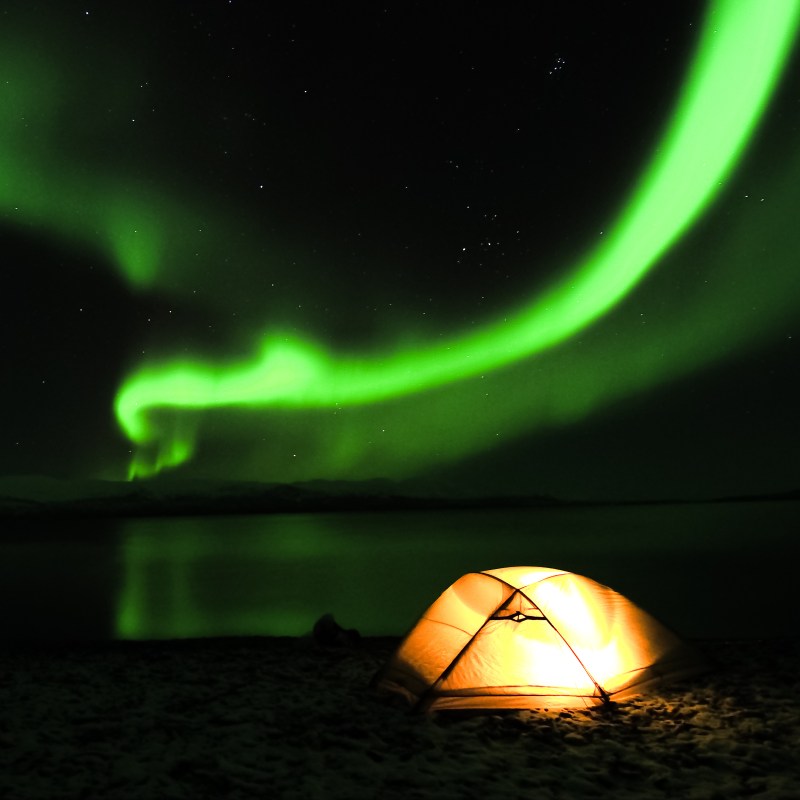
If you want to run with the bulls, you go to Pamplona. And if you want comfort in the Arctic (mysig, they call it; more about that soon), head to the Swedish Lapland. This undiscovered country is full of adventures — wilderness to explore, Arctic cuisine to taste, reindeer herders to talk to — and the northern lights.
Videos by TravelAwaits

Here’s what you need to know about the Swedish Lapland to start planning your next adventure, mysig guaranteed.

The Swedish Lapland Has 8 Seasons
Europe’s only indigenous people, the Sami, have called the Lapland region home for centuries. And the Sami recognize eight distinct seasons — a crucial distinction for a people who live in close harmony with nature. Many Swedes in the Lapland have adopted this understanding, too.
The four additional seasons recognized in Lapland lay in between the four seasons we’re familiar with, so don’t be surprised to hear terms like Spring-Winter, or “gidadalvve” in one Sami dialect, and Summer-Autumn, or “tjaktjagiesse” in another dialect, when conversing with the locals.
By the way, you should be able to get by just fine with English; about 86 percent of Swedes speak some English, so while it’s always a good idea to learn some basic phrases in the language of your destination, you probably won’t need Swedish proficiency to get by and enjoy a Lapland vacation.

The Lapland Is Isolated, And That’s A Good Thing
The Swedish Lapland’s extreme isolation is one of its greatest appeals. While the Lapland region itself stretches across Norway, Finland, and Russia, in addition to Sweden, Lappland (double p) is the Swedish province in the nation’s extreme north.
The Swedish Lapland Visitors Board makes this distant region accessible, however. Fly via one of a handful of carriers into Lulea or Kiruna, the two major airports located in Swedish Lapland. While you’ll probably fly into the region, once you’re there you can explore by train — and there’s plenty of mysig to be had onboard. One popular route runs between Lulea and Kiruna; it’s a great way to experience a taste of everything this remote region has to offer.

Coziness (Or Mysig) Is A Big Deal
Mysig is the new hygge. That latter concept — from Denmark –practically took over the internet in 2016. It must have been winter.
In any case, you might remember hygge: Fluffy socks and steaming mugs of tea, wool sweaters and lovers curled by the fire. As Oxford has it, hygge is “a quality of cosiness and comfortable conviviality that engenders a feeling of contentment or well-being.”
It stands to reason that if you travel north of Denmark to Sweden’s northernmost edges — literally in the Arctic Circle — something like hygge will become a survival strategy. Enter mysig, the Swedish concept of coziness. The Straits Times calls mysig “a Swedish term for the feeling of wanting to be warm and cosy, eat good food, and enjoy good conversation.”
So, how can you enjoy mysig during your trip? Well…

Coffee Breaks Are A Way Of Life
Fika is closely linked to mysig, and it’s a great entry point for understanding both concepts. It refers to a coffee break (or a tea break, if that’s more your speed), enjoyed with a fresh-baked pastry in a cozy setting. During fika, you contemplate life, relax, and take in the moment.
While you’d be forgiven for confusing fika with a simple coffee break, the Swedes don’t think of it that way. They prefer not to translate the word, as fika is an important national tradition. Fika typically lasts for 10 to 30 minutes, and tourists are encouraged to partake. Visit a coffeehouse or restaurant around 10 a.m. or 3 p.m to enjoy this social institution.

Yes, You Can See The Northern Lights
Swedish Lapland boasts some of the best views of the aurora borealis, that is, the northern lights. The lights are most visible September through March (True Autumn through True Winter), though it’s not guaranteed you’ll see the phenomenon when visiting.
The Aurora Sky Station in Abisko National Park has been called the best place in the world to watch the northern lights, but just about anywhere in Lapland would be an ideal setting. This magical sight is truly breathtaking to witness, so be sure to keep your eyes peeled and make time to focus on the sky.

The Lodgings Are Straight Out Of Fairy Tales
Forget the roadside motel. The Swedish Lapland offers accommodations that you have to see to believe. There’s the world-famous ICEHOTEL, for instance. Artists rebuild rooms out of ice and snow from the nearby Torne River every winter. There’s also a permanent building for warmer months.
If sleeping on a bed of ice isn’t for you, try Treehotel. Guest rooms are built into the pine trees of the Northern Swedish forest, and they are a sight to behold. The Mirrorcube structure is particularly enthralling; its mirrored exterior blends seamlessly with the surroundings, like sleeping in an invisible fortress.

It Offers Your Best Chance To Travel By Dog Sled
Dog sledding is a major part of life in the Swedish Lapland. Some area populations list more sled dogs than people!
Get to know these hardworking pups by booking a short trip at any one of the area’s ski resorts. Longer experiences are also available; some guides even take visitors on multi-day tours with pre-planned stops at log cabins.

It’s Great To Visit Any Time Of Year
So when should you travel to Swedish Lapland? That depends on what you want out of your journey. Northern lights chasers should visit for as long as possible between September and late March.
If experiencing the extraordinary landscape is your goal — whether you plan to hike, drive, or ride the train — responsible travel agency Jacada recommends arriving in June, July, or August. And for the iciest, snowiest, winteriest getaway of your life, head to the region from December to March — and prepare for the full mysig experience!
If you’re heart’s set on seeing the northern lights, it’s time to consider these 10 hotels with northern lights views. Or, if you’re in it for the adorable animals, read up on nine places to see reindeer in the wild (including Swedish Lapland, of course).


